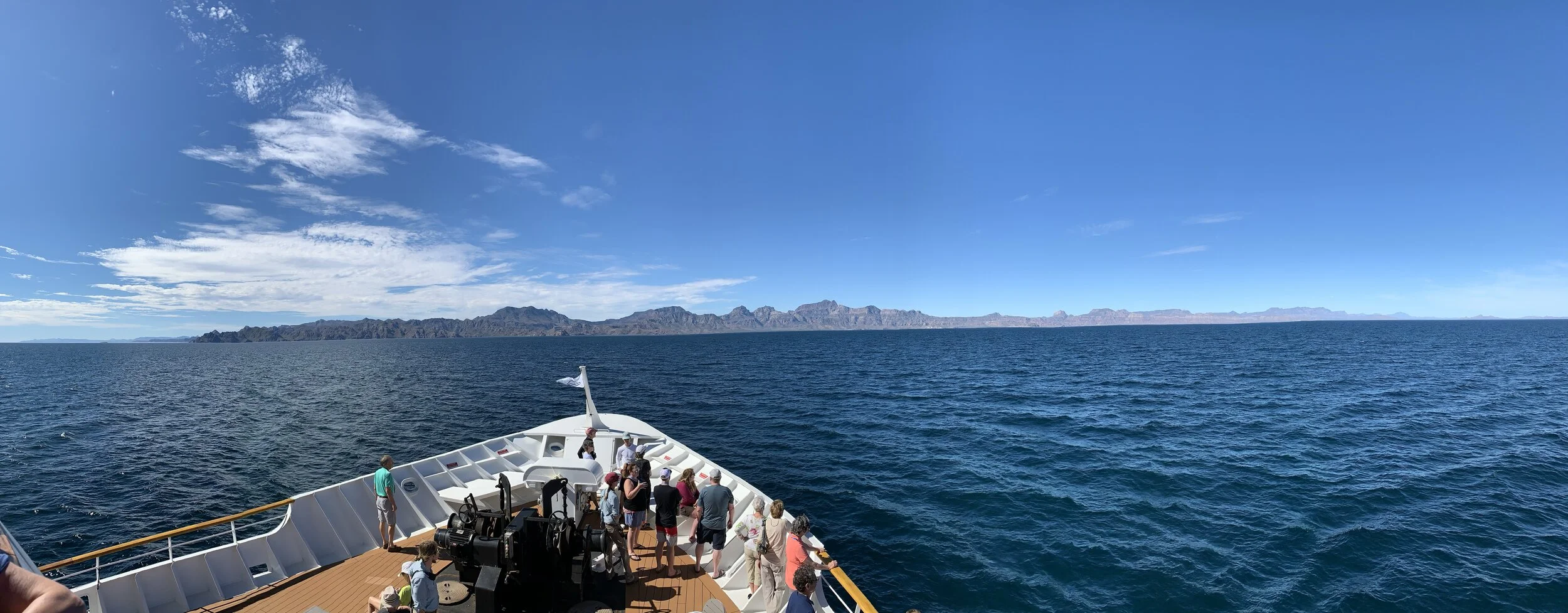After breakfast on Wednesday, everyone loads up into 7 or 8 vans and drive across the peninsula to Magdalena Bay. This is one of four primary bays that gray whales migrate to each winter to breed and give birth to their young. It’s a pretty easy drive that takes us across several different types of landscapes. We start out in a very green, mountainous area and then gradually transition into flatlands that are much more arid and desert like. We pass large numbers of osprey nests that have been built on polls the government has built alongside power lines along the road. It’s a pretty easy ride which includes a quick break for muffins from Renata, the pastry chef (we gotta keep eating!). Before long we arrive on the west cost at a marina. After donning sunscreen and life vests, we get into panga boats and head out in search of whales.
We have Kelly as our guide in our panga, and we are not at all surprised to learn that she gets really excited throughout the morning. Within 5 minutes of leaving the marina, we’ve spotted our first mom/baby whale pair. We come to a stop and almost immediately the pair comes toward our boat. Apparently gray whales are fairly inquisitive and also like rubbing the barnacles on their backs against the boats. These two repeatedly pass alongside or under our boat. Eventually, the mom passes close enough to the boat that Travis is able to read out and touch her. As it turns out, he ends up being the only passenger (out of 54) that is able to touch one of them. Kelly is the only other person who manages it today (and vows she’s never washing her hand). Despite that, the whales are incredibly close and everyone ends up getting “misted” from whale blowhole blows throughout the several hours we’re out on the water. While we’re hanging around that first pair, there is another panga nearby that has a Mexican family on it. Every time a whale approaches their panga, several of the women on the boat scream as if a great white shark is bearing down on them. The rest of their family, as well as all the occupants of nearby pangas are laughing hysterically at the screams. It’s pretty funny.
Various things we learned:
The adult whales don’t feed while they’re down in Mexico.
The baby whales nurse the whole time (the milk has the consistency of yogurt) and gain tons of weight before they head north in mid/late March
The whales actually have two blow-holes side-by-side that produce a vaguely heart shaped blow pattern (we were told this, but neither of us is sure we ever saw any blows that looked particularly heart shaped)
The males start returning north earlier than the nursing females
Females typically have a baby every other year
One can get a sense of how old the babies are based on how many barnacles they have on their backs
We spot a number of pairs while in the bay, but then ultimately head out to the open ocean for a while (after following a small pod of dolphins for a bit). The water is significantly rougher out there, but there do tend to be a bunch of whales and we seem to constantly be coming upon pairs. There are a bunch of our group’s pangas out there and it’s also fun watching all of them watching the whales. Our panga captain is fairly old and we decide he’s done this a lot. He spots whales quickly and often sort of ends up in the right place for them to surface near by. It ends up being a fantastic morning and we’re both quite sure we’ll never have a better whale watching trip again.
After heading back to shore, everyone loads up and heads to a local restaurant where we have a nice seafood lunch. We end up with a bit of time after lunch to wander around and discover several ospreys hanging out in nests and rolling cardboard school crossing guards. On the van ride back to the ship, we have Renata’s cookies (she never stops baking!), and folks get their internet fix (as we rarely have any internet access on the ship).
At happy hour, we learn that we’ll be cruising for wildlife in the morning. In the afternoon, there will be another beach party that will be the starting point for various activities. We decide to do a tide pool walk and hope that we’ll also have time to do some snorkeling off the beach.
After dinner, the presentation is a slideshow of underwater photography by Scott, the ship’s Chief Mate. He’s recently spent five weeks scuba diving around Cabo San Lucas. As it turns out, he’s a great photographer and has some really incredible photos.
56 Second video of Mom & Baby gray whale in Magdalena Bay, Sea of Cortez.
Looks like we’re falling off the edge of the world!
Or group just before departing on our three hour tour (Doug has packed a tuxedo - he’s seen Gilligan’s Island and knows to be prepared)
Here we go…
Kelly tells us to point when we spot a whale - we may not understand the instructions
Various whale pictures:
Travis touches a baby whale
“Look ma - no barnacles!”
Our panga captain
Look at those blow-holes!
Travis with the crossing guard
As osprey siting after lunch









